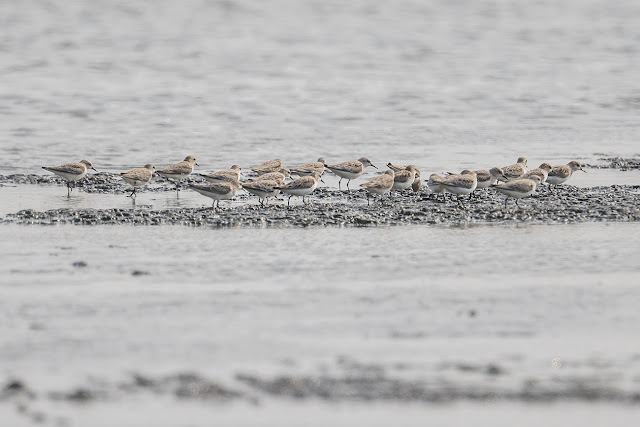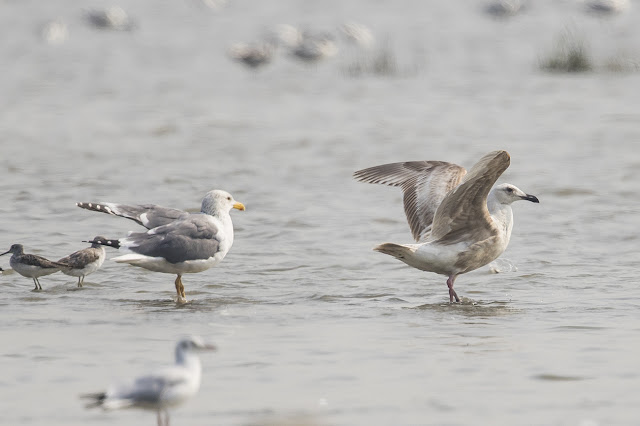Spring is definitely amongst us, with Koels singing louder and louder everyday and Large Hawk Cuckoos now joining in as well. Birds are now starting to get into pairs to build nests, if not then they are trying their best to! I was out mothing with Hoiling and the moth group last week at Lung Fu Shan, and was delighted to hear a pair of Collared Scops Owl calling nearby, one was making the classic "oh" call while the other making a much softer whistle which I never heard before. I guess they were a pair trying to find a suitable spot for nesting, I caught glimpses of the pair and finally was able to get a photo of one perched at close range!
Collared Scops Owl
Long Valley had been very quiet, people had been getting Oriental Pratincoles and Red-necked Phalaropes on passage, but I got none of those on a short visit. A few brilliant looking adult Little Ringed Plovers were there to entertain and they truly are cracking birds when seen up close.
Little Ringed Plover
With everywhere else quiet I thought it's best to stick to Mai Po. I headed into the Deep Bay hide fairly early, on the way I got a nice looking male Taiga Flycatcher just moulting into breeding plumage.
Taiga Flycatcher
I was quite early when I got to the bird hide. A few Black-faced Spoonbills in breeding plumage were in front of the hide, looking rather splendid with their yellow breast and huge crests. Great Egrets have also moulted into breeding plumage, their long plumes cascade down their backs, while their bill turns black and face turns greenish blue.
Black-faced Spoonbill - breeding plumage
Great Egret - breeding plumage
Of all egrets perhaps the Chinese Pond Heron undergo the most amazing transformation, where they moult from their cryptic winter plumage into colourful breeding plumage with reddish brown heads and breast, bluish black backs and white wings. Their face and bill colour also undergo much transformation, from dull yellow to orange, blue and green. At this time of the year you may still find individuals retaining their non-breeding plumage, and often you get individuals in-between.
Chinese Pond Heron - non-breeding to breeding plumage
A mudskipper collector prowled the mudflats, these illegal collectors can be rather annoying, as they often scare away the birds and blatantly catch fish in this ramsar site. But what's more annoying is that calling the police or the AFCD often ends in vain as they quickly vanishes into the thick mangroves before authorities arrives.
As the tide came in birds started coming in closer, although I was a bit disappointed by the fact that there weren't much smaller waders like Stints, I barely saw a single Curlew Sandpiper! Whether the mudskipper collector had anything to do with this I am not sure...the Black-headed Gulls harassed pretty much any bird that caught a fish, including this Great Egret. Black-faced Spoonbills followed the tide in and will often get very close to the hide.
Great Egret harassed by Black-headed Gulls
Black-faced Spoonbill - breeding plumage
Waders such as Marsh Sandpipers, Common Greenshanks, Spotted Redshanks and Common Redshanks were in good numbers, but even Greater Sand Plovers, Grey Plovers and Kentish Plovers were surprisingly scarce...Caspian Terns were however in fairly good numbers now.
Marsh Sandpiper
Caspian Tern
While the Black-capped Kingfisher had already gone, a Common Kingfisher takes it's place. A pair of Pied Kingfishers also came by briefly, the male caught a fish and perched on one of the "kingfisher pole".
Common Kingfisher - female
Pied Kingfisher - male
There were still plenty of large gulls around, including Mongolian Gulls and Heuglin's Gulls. A fairly pale looking 1st winter Slaty-backed Gull was perhaps the only interesting bird on the mudflat.
Mongolian Gull - sub adult
Heuglin's Gull - 1st winter
Slaty-backed Gull - 1st winter
Everything left once the tide came in, only bird of interest was a single Great Crested Grebe in breeding plumage. The bird hide floated around on the water, I decided to wait for the tide the recede, good time for an afternoon nap.
Great Crested Grebe
The receding tide was delayed by the strong northerly winds, it was still 2.14m at 3pm, it wasn't until 4pm that we started seeing more movements. I spotted a large white gull in the distance which surely was a Glaucous Gull. It was very very far away so all I could do was hope for it to come over as the tide recede further.
Glaucous Gull in the distance
While I waited, a few 1st winter Saunders's Gull flew past, most of the breeding birds had already left, and we often get a few non-breeding individuals staying slightly longer. This species is now listed as vulnerable due to habitat loss from land reclamation along their breeding range.
Saunders's Gull - 1st winter
A flock of Red-necked Stints finally came down to the mudflat, the reason for their absent during the incoming tide remains a bit of a mystery. Eurasian Curlews were in good numbers, I spotted a Far Eastern Curlew really far out.
Red-necked Stint
Eurasian Curlew
I put my attention back to the gulls present. A few adult Mongolian Gulls were there, the paler heads were quite obvious. However, a strange looking gull grabbed my attention, it was rather small headed with a fairly weak bill with dark tip. It had very little streaking on the head which resembles Mongolian, although it had very well-defined dark streaks on it's nape which somehow reminds me of 1st winter Relict Gulls. Back looked fairly dark, well within range of Heuglin's perched next to it. Legs were yellowish which doesn't quite fit Mongolian...What's more, it had barely any mirror visible, with a somewhat nearly all dark wing tip. I did some research and this is nearly identical to what had been named the "Yellow Sea Gull" on a page call 'A consideration of "The Herring Gull Assemblage" in South Korea' by Nial Moores on Birds Korea's website (http://www.birdskorea.org/Birds/Identification/ID_Notes/BK-ID-Herring-Gull-Page2.shtml), under what they had named "Type D" Mongolian Gulls. I guess this will remain a bit of a mystery for now...
Mongolian Gull - adult
Strange looking gull to the right...
The 1st winter Slaty-backed Gull came in with the other large gulls. 1st winter birds in late winter are often very worn out like this bird, with coverts and tertiaries bleached and becoming quite pale.
Slaty-backed Gull - 1st winter
Finally, the 1st winter Glaucous Gull decided to drop over to our side, although against the sun...This is most probably the same bird I encountered late last month, although it had bleached slightly, it still showed that fairly dark belly. This bird raised some concerns over it's identity due to it's smaller size, from the side it looked chunky, but certainly wasn't a very tall looking bird especially when it's hunched up, but it was certainly larger than the rest of the Gulls present. Either way, I was quite happy to count it as a Glaucous Gull last month, I saw nothing that may change my mind on it's identity.
Glaucous Gull - 1st winter
migration season is well underway, but I haven't seen much yet...





























No comments:
Post a Comment